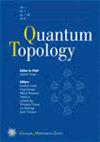Dual bases in Temperley–Lieb algebras, quantum groups, and a question of Jones
IF 1
2区 数学
Q1 MATHEMATICS
引用次数: 4
Abstract
We derive a Laurent series expansion for the structure coefficients appearing in the dual basis corresponding to the Kauffman diagram basis of the Temperley-Lieb algebra $\text{TL}_k(d)$, converging for all complex loop parameters $d$ with $|d| > 2\cos\big(\frac{\pi}{k+1}\big)$. In particular, this yields a new formula for the structure coefficients of the Jones-Wenzl projection in $\text{TL}_k(d)$. The coefficients appearing in each Laurent expansion are shown to have a natural combinatorial interpretation in terms of a certain graph structure we place on non-crossing pairings, and these coefficients turn out to have the remarkable property that they either always positive integers or always negative integers. As an application, we answer affirmatively a question of Vaughan Jones, asking whether every Temperley-Lieb diagram appears with non-zero coefficient in the expansion of each dual basis element in $\text{TL}_k(d)$ (when $d \in \mathbb R \backslash [-2\cos\big(\frac{\pi}{k+1}\big),2\cos\big(\frac{\pi}{k+1}\big)]$). Specializing to Jones-Wenzl projections, this result gives a new proof of a result of Ocneanu, stating that every Temperley-Lieb diagram appears with non-zero coefficient in a Jones-Wenzl projection. Our methods establish a connection with the Weingarten calculus on free quantum groups, and yield as a byproduct improved asymptotics for the free orthogonal Weingarten function.坦波利-里布代数中的对偶基,量子群,以及琼斯的一个问题
我们对出现在对应于Temperley-Lieb代数$\text{TL}_k(d)$的Kauffman图基的对偶基中的结构系数导出了一个Laurent级数展开式,该展开式收敛于所有复杂回路参数$d$与$|d| > 2\cos\big(\frac{\pi}{k+1}\big)$。特别地,这产生了$\text{TL}_k(d)$中Jones-Wenzl投影的结构系数的新公式。在每个劳伦展开式中出现的系数被证明有一个自然的组合解释,根据我们在非交叉配对上放置的某个图结构,这些系数证明具有一个显著的性质,即它们要么总是正整数,要么总是负整数。作为应用,我们肯定地回答了Vaughan Jones的一个问题,即在$\text{TL}_k(d)$(当$d \in \mathbb R \backslash [-2\cos\big(\frac{\pi}{k+1}\big),2\cos\big(\frac{\pi}{k+1}\big)]$)的每个对偶基元展开中是否每个Temperley-Lieb图都以非零系数出现。专门研究Jones-Wenzl投影,这个结果给出了Ocneanu结果的一个新的证明,说明在Jones-Wenzl投影中,每个Temperley-Lieb图都以非零系数出现。我们的方法建立了与自由量子群上的Weingarten微积分的联系,并作为副产品得到了自由正交Weingarten函数的改进渐近性。
本文章由计算机程序翻译,如有差异,请以英文原文为准。
求助全文
约1分钟内获得全文
求助全文
来源期刊

Quantum Topology
Mathematics-Geometry and Topology
CiteScore
1.80
自引率
9.10%
发文量
8
期刊介绍:
Quantum Topology is a peer reviewed journal dedicated to publishing original research articles, short communications, and surveys in quantum topology and related areas of mathematics. Topics covered include in particular:
Low-dimensional Topology
Knot Theory
Jones Polynomial and Khovanov Homology
Topological Quantum Field Theory
Quantum Groups and Hopf Algebras
Mapping Class Groups and Teichmüller space
Categorification
Braid Groups and Braided Categories
Fusion Categories
Subfactors and Planar Algebras
Contact and Symplectic Topology
Topological Methods in Physics.
 求助内容:
求助内容: 应助结果提醒方式:
应助结果提醒方式:


